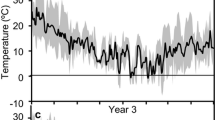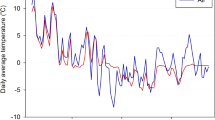Abstract
The thermogenesis and flowering biology of Colocasia gigantea (Blume) Hook. f. were studied from December 2005 to February 2006 on Espiritu Santo, Vanuatu (South Pacific). Endogenous thermogenesis was measured in two ways: (1) continuously over 5-day periods, and (2) over 3 h during maximum heating. The study showed that heat was generated by the male part of the spadix and probably the lower zone of the sterile region. The temperatures of the male part peaked twice: (1) between 0625 and 0640 (during the female phase) and (2) 24 h later (during the male phase). The average maximum temperature was 42.25 ± 0.14°C during the female phase (16.63°C above the ambient temperature) and 35.14 ± 0.22°C during the male phase (10.61°C above the ambient temperature). In the lower zone of the sterile region, thermogenesis was documented only during the female phase. The average maximum temperature was 35.44 ± 0.41°C (9.82°C above the ambient temperature). Thermogenic heating appeared to be closely associated with the activities of pollinating insects.





Similar content being viewed by others
References
Albre J, Quilichini A, Gibernau M (2003) Pollination ecology of Arum italicum (Araceae). Bot J Linn Soc 141:205–214
Barabé D, Gibernau M (2000) Étude comparative de la production de chaleur chez quelques Araceae. Adansonia 22:253–263
Barabé D, Lacroix D, Gibernau M (2003) Development of the flower and inflorescence of Arum italicum (Araceae). Can J Bot 81:622–632
Cai X-Z, Long C-L, Liu K-M (2006) Colocasia yunnanensis (Araceae), a new species from Yunnan, China. Ann Bot Fenn 43:139–142
Chouteau M, Barabé D, Gibernau M (2007) Thermogenesis in Syngonium (Araceae). Can J Bot 85:184–190
Gibernau M, Barabé D (2000) Thermogenesis in three Philodendron species (Araceae) of French Guiana. Can J Bot 78:685–689
Gibernau M, Barabé D (2002) Pollination ecology of Philodendron squamiferum (Araceae). Can J Bot 80:316–320
Gibernau M, Barabé D, Labat D, Cerdan P, Dejean L (2003) Reproductive biology of Montrichardia arborescens (Araceae) in French Guiana. J Trop Ecol 19:103–107
Gibernau M, Barabé D, Moisson M, Trombe A (2005) Physical constraints on temperature difference in some thermogenic aroid inflorescences. Ann Bot 96:117–125
Ivancic A, Lebot V (1999) Botany and genetics of New Caledonian wild taro, Colocasia esculenta. Pac Sci 53:273–285
Ivancic A, Lebot V (2000) The genetics and breeding of taro. Series Rèperes. CIRAD, Montpellier
Ivancic A, Lebot V, Roupsard O, Quero Garcia J, Okpul T (2004) Thermogenic flowering of taro (Colocasia esculenta, Araceae). Can J Bot 82:1557–1565
Ivancic A, Roupsard O, Quero Garcia J, Lebot V, Pochyla V, Okpul T (2005) Thermogenic flowering of the giant taro (Alocasia macrorrhizos, Araceae). Can J Bot 83:647–655
Kramadibrata K, Hambali GG (1983) Peranan beberapa serangga pengunjung perbungaan pada penyerbukan Colocasia esculenta var. esculenta dan C. gigantea (The roles of some insects in pollination of Colocasia esculenta var. esculenta and C. gigantea). Berita Biol 2:143–146
de Lamarck J-B (1778) Flore française. Tome 3; L’Imprimerie Royale, Paris, p 538
Lamprecht I, Schmolz E, Blanco L, Romero CM (2002) Flower ovens: thermal investigations on heat producing plants. Thermochim Acta 391:107–118
Leick E (1915) Die Erwärmungstypen der Araceen und ihre blütenbiologische Deutung. Berichte der Deutschen Botanischen Gesellschaft 33:518–536
Maia ACD, Schlindwein C (2006) Caladium bicolor (Araceae) and Cyclocephala celata (Coleoptera, Dynastinae): a well-established pollination system in the northern Atlantic rainforest of Pernambuco, Brazil. Plant Biol (Stuttg) 8:529–534
Matthews PJ (2004) Taro. In: Krech S III, McNeill JR, Merchant C (eds) Encyclopedia of world environmental history, vol 3. Routledge, New York London, pp 1185–1186
Meeuse BJD, Raskin I (1988) Sexual reproduction in the arum family, with emphasis on thermogenicity. Sex Plant Reprod 1:3–15
Miyake T, Yafuso M (2003) Floral scents affect reproductive success in fly-pollinated Alocasia odora (Araceae). Am J Bot 90:370–376
Nagy KA, Odell DK, Seymour RS (1972) Temperature regulation by the inflorescence of Philodendron. Science 178:1195–1197
Naiola BP, Danimihardja S, Imamuddin H (1984) Flowering behavior in Colocasia gigantea Hook. f. In: Shideler FS, Rincon H (eds) Proceedings of the sixth symposium of the international society for tropical root crops, 21–26 February 1983. International Potato Center (CIP), Lima, Peru, p 131
Raskin I, Turner IM, Melander WR (1989) Regulation of heat production in the inflorescences of an Arum lily by endogenous salicylic acid. Proc Natl Acad Sci U S A 86:2214–2218
Schmucker T (1925) Beiträge zur Biologie und Physiologie von Arum maculatum. Flora 118/119:460–475
Seymour R (1999) Pattern of respiration by intact inflorescences of the thermogenic arum lily Philodendron selloum. J Exp Bot 50:845–852
Seymour RS, Blaylock AJ (1999) Switching off the heater: influence of ambient temperature on thermoregulation by eastern skunk cabbage Symplocarpus foetidus. J Exp Bot 50:1525–1532
Seymour RS, Schultze-Motel P (1999) Respiration, temperature regulation and energetics of thermogenic inflorescences of the dragon lily Dracunculus vulgaris (Araceae). Proc R Soc Lond B Biol Sci 266/1432:1975–1983
Seymour RS, Gibernau M, Ito K (2003) Thermogenesis and respiration of the dead horse arum Helicodiceros muscivorus, a pseudo-thermoregulatory aroid associated with fly pollination. Funct Ecol 17:886–894
Skubatz H, Nelson TA, Meeuse BJD, Dong AM, Bendich AJ (1990) Infrared thermography of Arum lily inflorescences. Planta 182:432–436
Skubatz H, Nelson TA, Meeuse BJD, Bendich AJ (1991) Heat production in the voodoo lily (Sauromatum guttatum) as monitored by infrared thermography. Plant Physiol 95:1084–1088
Takenaka K, Yin J-T, Wen S-Y, Toda MJ (2006) Pollination mutualism between a new species of the genus Colocasiomyia de Meijere (Diptera: Drosophilidae) and Steudnera colocasiifolia (Araceae) in Yunnan, China. Entomol Sci 9:79–91
Weightman B (1989) Agriculture in Vanuatu—a historical review. The British Friends of Vanuatu. Grosvenor, Portsmouth
Yafuso M (1993) Thermogenesis of Alocasia odora (Araceae) and the role of Colocasiomyia Flies (Diptera: Drosophilidae) as cross-pollinators. Popul Ecol 22/3:601–606
Author information
Authors and Affiliations
Corresponding author
Rights and permissions
About this article
Cite this article
Ivancic, A., Roupsard, O., Garcia, J.Q. et al. Thermogenesis and flowering biology of Colocasia gigantea, Araceae. J Plant Res 121, 73–82 (2008). https://doi.org/10.1007/s10265-007-0129-5
Received:
Accepted:
Published:
Issue Date:
DOI: https://doi.org/10.1007/s10265-007-0129-5




